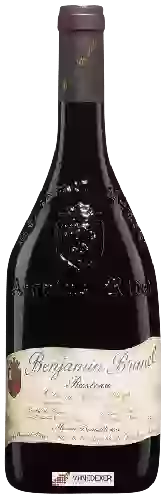The Winery Bernard Pere & Fils of Saint-Émilion of Bordeaux

The Winery Bernard Pere & Fils is one of the best wineries to follow in Saint-Émilion.. It offers 16 wines for sale in of Saint-Émilion to come and discover on site or to buy online.
Looking for the best Winery Bernard Pere & Fils wines in Saint-Émilion among all the wines in the region? Check out our tops of the best red, white or effervescent Winery Bernard Pere & Fils wines. Also find some food and wine pairings that may be suitable with the wines from this area. Learn more about the region and the Winery Bernard Pere & Fils wines with technical and enological descriptions.
How Winery Bernard Pere & Fils wines pair with each other generally quite well with dishes of beef, lamb or game (deer, venison) such as recipes of beef tenderloin wellington, leg with a spoon or seven o'clock leg or rabbit with prunes.
On the nose the red wine of Winery Bernard Pere & Fils. often reveals types of flavors of cherry, oaky or earthy and sometimes also flavors of tobacco, leather or cranberry. In the mouth the red wine of Winery Bernard Pere & Fils. is a powerful with a nice balance between acidity and tannins.
The wine region of Saint-Émilion is located in the region of Libournais of Bordeaux of France. Wineries and vineyards like the Domaine Baron Philippe de Rothschild or the Château Le Chatelet produce mainly wines red and white. The most planted grape varieties in the region of Saint-Émilion are Merlot, Cabernet franc and Cabernet-Sauvignon, they are then used in wines in blends or as a single variety. On the nose of Saint-Émilion often reveals types of flavors of black fruits, savory or cocoa and sometimes also flavors of bramble, raisin or sour cherry.
In the mouth of Saint-Émilion is a powerful with a nice balance between acidity and tannins. We currently count 645 estates and châteaux in the of Saint-Émilion, producing 833 different wines in conventional, organic and biodynamic agriculture. The wines of Saint-Émilion go well with generally quite well with dishes of beef, lamb or game (deer, venison).
How Winery Bernard Pere & Fils wines pair with each other generally quite well with dishes such as recipes .
Sémillon blanc is a grape variety that originated in France (Bordeaux). It produces a variety of grape specially used for wine making. It is rare to find this grape to eat on our tables. Note that this grape variety can also be used for the elaboration of eaux de vie. This variety of vine is characterized by large bunches of grapes, and grapes of large size. Sémillon Blanc can be found in several vineyards: South-West, Languedoc & Roussillon, Cognac, Bordeaux, Armagnac, Provence & Corsica, Loire Valley, Rhone Valley, Savoie & Bugey, Beaujolais.
How Winery Bernard Pere & Fils wines pair with each other generally quite well with dishes of rich fish (salmon, tuna etc), shellfish or vegetarian such as recipes of salmon pave en papillotte, fried rice with shrimp and chicken or zucchini quiche.
The flavour provided by the residual sugars naturally present in the wine as well as by certain alcohols. This sensation can range from a simple impression of smoothness to a clear sweetness. We speak of roundness, fatness and mellowness.
How Winery Bernard Pere & Fils wines pair with each other generally quite well with dishes of shellfish, appetizers and snacks or lean fish such as recipes of pasta with vongoles (flat clams), cake with olives and bacon or monkfish with cream sauce and baked potatoes.
Merlot noir is a grape variety that originated in France (Bordeaux). It produces a variety of grape specially used for wine making. It is rare to find this grape to eat on our tables. This variety of grape is characterized by small to medium sized bunches, and medium sized grapes. Merlot noir can be found in many vineyards: South West, Languedoc & Roussillon, Cognac, Bordeaux, Loire Valley, Armagnac, Burgundy, Jura, Champagne, Rhone Valley, Beaujolais, Provence & Corsica, Savoie & Bugey.
Planning a wine route in the of Saint-Émilion? Here are the wineries to visit and the winemakers to meet during your trip in search of wines similar to Winery Bernard Pere & Fils.
Grenache noir is a grape variety that originated in Spain. It produces a variety of grape specially used for the elaboration of wine. It is rare to find this grape to eat on our tables. This variety of grape is characterized by medium to large bunches, and grapes of medium size. Grenache noir can be found in many vineyards: South West, Cognac, Bordeaux, Provence & Corsica, Languedoc & Roussillon, Rhone Valley, Loire Valley, Savoie & Bugey, Beaujolais.